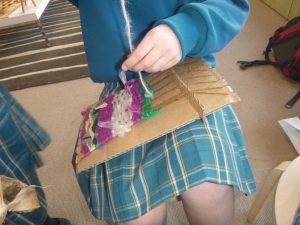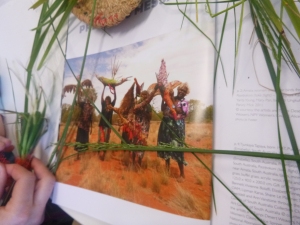I would like to acknowledge the Kaurna people – the traditional owners of the lands and waters where the city of Adelaide has been built.
Reconciliation works ’to bring peoples and their different as well as common histories, interests and aspirations together, in a just and progressive cause, through thorough examination of privilege and ‘progress’ on the one hand and redress, rights and needs on the other (G Worby, 2006).’
School is a place where all students need to know that they belong. The classroom needs to be a safe space where all students are supported in their growth and development as individuals, within a learning community. In order to create such an environment it is my role to understand and value diversity and teach inclusivity. ‘Inclusivity’ actively recognises and validates Indigenous cultures within schools, supporting wellbeing and success in all students (MCEECDYA, 2010-2014). In order to connect across boundaries, a collaborative environment is necessary. Diversity is supported, celebrated and personal stories are welcome and acknowledged (Australia, 2013), (MCEECDYA, 2010-2014), (Hooks, 1994), (Rahman, 2010) (Yunggorendi, 2013).
I believe that I have met the criteria of standard 2.4 Understand and respect Aboriginal and Torres Strait Islander people to promote reconciliation between Indigenous and non-Indigenous Australians by doing the following:
- This year, within my year 4 Art classes, students explored Aboriginal symbols. They then designed their own symbols that expressed something that is important to them.
 Students first told a story using Australian Aboriginal symbols and then constructed their own symbol. They then made a wooden block stamp from recycled materials which they printed with and made artworks for presentation.
Students first told a story using Australian Aboriginal symbols and then constructed their own symbol. They then made a wooden block stamp from recycled materials which they printed with and made artworks for presentation.



- I developed a Critical Indigenous Pedagogical Practice (CIPP) in order to meet the needs of Indigenous Australian and Torres Strait Islander students and promote reconciliation between Indigenous and non-Indigenous students. Within my CIPP, I work towards equity in learning outcomes for all students with excellence accessible to all. I use key strategies in the maintenance of an engaged pedagogy which will assist in the success of Indigenous and Torres Strait Islander students at school.
Critical Indigenous Pedagogical Practice
Within the CIPP, (please open link above), Indigenous knowledges have been privileged. Students explore connection to place and care for Country through learning within relationships, story, language, Art and Geography. Students collaborate with other classes, families and local community in the development of an artwork at the school, promoting reconciliation. Activities support a variety of learning modes and promote engagement.
- I worked with a diverse group if Foundation students. There were a number of Indigenous Australian children within the class. I developed and implemented a History unit which I integrated with English. A literature study was used as a basis for the development a class ‘big book’, exploring family structures, celebrating diversity and promoting reconciliation.
Please open following links to see my Literature Unit Plan. Literature Study Unit Plan and my History Unit Plan History Unit Plan
Images above (left) Indigenous Language Map used within the unit plan: Image retrieved from http://bit.ly/19oPtWC & (right) children’s book used as a basis for learning about Indigenous family structures and diversity- ‘Tom Tom’ by Rosemary Sullivan, 2008 (Sullivan, 2008).
The images above show examples of students work. The pictures are taken from the class ‘big book’ created by the children titled ‘Our Families’.
- I developed a series of small ‘Inquiries’. Students explored Indigenous Australian culture and histories through a range of artifacts. Students looked into Indigenous Australian Art and food sources, making connections and building understanding about care of Country.
Above are a series of images taken whilst facilitating small ‘Inquiries’ with Year 1/2 students in 2013. These small introductory learning experiences were designed to spark interest and instigate further investigation into Indigenous Australian culture and histories, with a focus on care of Country, bush foods and Art.
Excerpts From Professional Experience Reports 2012/2013:
Learning Content
“Lesson content was always well researched using the school library, mentor’s resources, internet, own resources and through questioning and observations and she demonstrated a sound understanding of the areas she delivered. Both S.A.C.S.A. and The Australian Curriculum were used to plan successful lessons. Strategies were discussed prior to planning to ensure that all objectives were embraced. Outcomes were clearly defined and managed” Year Three mentor teacher, 2012.
“Heidi shows she has very good knowledge of the content and how to write and reference lesson plans. She is able to source and confidently use the ACARA curriculum documents to design creative and well-structured lessons that are interesting and motivating for the children.” Foundation year mentor teacher 2013
Learner Context
“Heidi was aware of students who were on NEP’s, at risk with their learning, of aboriginal background, had autism or who had social or behavioral issues. As a result, Heidi had a balanced relationship with these students and was able to support these students appropriately when the need arose to achieve their learning outcomes. Discussions re these students, was always taking place. She consistently gave students encouragement and positive reinforcement to do their best, taking into account individual needs.” Year three mentor teacher, 2012
Where to next?
In order to meet the needs of Indigenous Australian and Torres Strait Islander students, I will continue to develop my understanding around collaborative learning strategies. I will focus on building positive relationships with families and community members in order to create a safe and nurturing learning space in which the Indigenous and Torres Strait Islander students would engage positively and confidently. I will continue to grow my understanding around Indigenous Australian knowledges, histories and current issues. In order to maintain development in these areas I could visit the Australian Education Union Website to access a course in collaborative learning strategies and keep up to date with successful and current strategies for teaching Indigenous and Torres Strait Islander students via the What Works. The Work Program website.
References
Australia, C. o., 2013. What Works The Work Program. [Online]
Available at: http://www.whatworks.edu.au/dbAction.do?cmd=homePage
[Accessed 24 8 2013].
Hooks, B., 1994. Education as the Practise of Freedom. New York: Routledge.
MCEECDYA, 2010-2014. Indigenous Education Action Plan Draft, s.l.: s.n.
Rahman, K., 2010. Addressing the Foundations for Improved Indigenous Secondary Student Outcomes: A south Australian Qualitative Study. The Australian Journal of Indigenous Education, Volume 39, pp. 65-76.
Sullivan, R. (2008). Tom Tom. Adelaide: Working Title Press.
Worby, F. B. &. G., 2008. The silences Waiting: young Nunga males, curriculum and rap. Curriculum Perspectives, 30(1), pp. 1-13.
Yunggorendi, 2013. FLO. [Online]
Available at: http://flo.flinders.edu.au/course/view.php?id=14883
[Accessed 24 8 2013].














